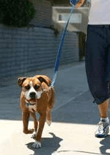Leash Training Tips to Enjoy Your Walks
By Sally Gutteridge | Behavior

 Taking your dog for a walk on a leash shouldn’t mean that your dog is pulling you down the block! Proper leash training will make walking your dog on a day-to-day basis a pleasant experience. As your dog learns how to walk obediently on a leash, he will remain by your side at all times without any tension or pulling.
Taking your dog for a walk on a leash shouldn’t mean that your dog is pulling you down the block! Proper leash training will make walking your dog on a day-to-day basis a pleasant experience. As your dog learns how to walk obediently on a leash, he will remain by your side at all times without any tension or pulling.
Before You Begin Leash Training
Before leash training even begins, teach your dog to remain calm when you put his leash on. Many dogs will get excited the second that they see their leash because they know that they are going to go outside on a walk. Command your dog to sit and stay quietly when you put on the leash so that he becomes obedient to you before beginning a walk.
If your dog begins to jump and react to the leash, wait to begin the walk until he sits down calmly for at least a minute. Most dogs learn how to quickly master the “sit” command. When you use this command as a requirement for starting a walk, your dog will understand that he must obey if he wants to go out on the leash.
How to Stop Pulling: At Home
You can practice leash training at home first of all to teach your dog good behavior on a leash. Attach the leash to your dog’s collar and stand still while holding the leash next to your body. Your dog may start jumping with excitement, but when you stand still, your dog will start to calm down.
As soon as your dog calms down, give him a treat and praise to reinforce the good behavior.
When your dog sits or stands at your side for a moment without jumping, reward and say “go” while taking a step forward. After you take the first step, stand still again. If your dog begins to jump or get excited, wait for him to stand still until you continue. Once he stands still, praise and reward with a treat.
Repeat this behavior several times until your dog learns to calm down each time that you take a step forward.
How to Stop Pulling: On a Walk
If your dog is new to leash training or is a puppy, his most common instinct is to pull at the leash. If your dog is pulling on the leash, do not walk, instead go in the other direction.
As soon as your dog responds to you and begins walking without pulling on the leash, praise him and give him a treat for his good behavior. This positive reinforcement will show your dog the correct way to walk on a leash; because of the reward, he will be likely to repeat his good behavior again and again.
Leash Training Mistakes to Avoid
If your dog is new to leash training, patience is the best tool to have on your side. Any time that your dog pulls or runs ahead, he must understand that his behavior is unacceptable. You must stop in your tracks or turn in the other direction until your dog corrects his bad behavior.
Once your dog calms down and walks by your side, he can be rewarded with a treat to positively reinforce the action. When walking on a leash, it’s you – not your dog – who is the leader!
Session expired
Please log in again. The login page will open in a new tab. After logging in you can close it and return to this page.
can anybody help me i have a king charles called lola and she just is realy jumpy and never calms down all i need is some tips on how to calm her down thx guys
How much exercise does she get? Usually bad behavior can be curbed by morning and/or daily exercise.